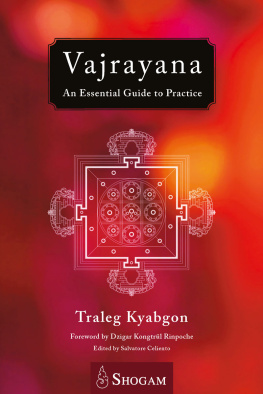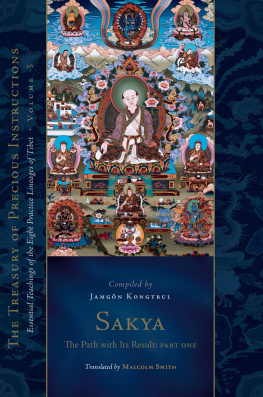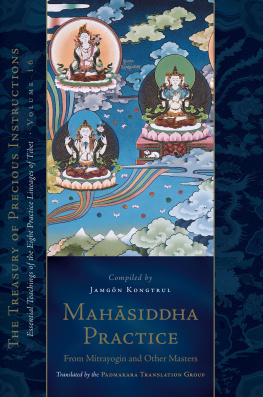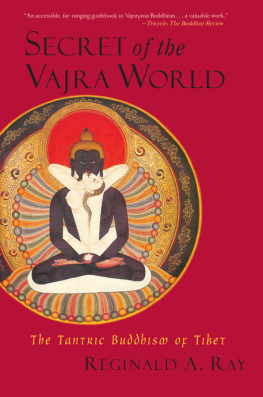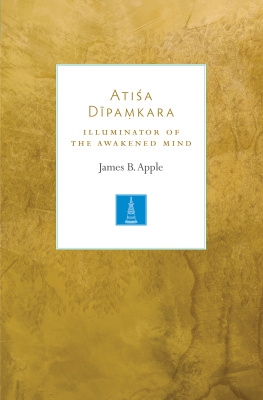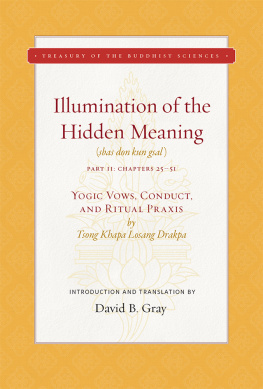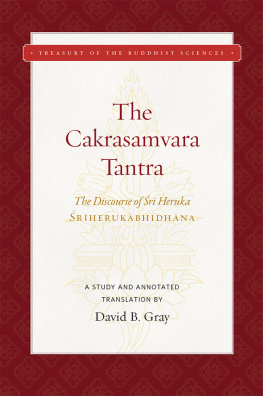
T REASURY OF THE B UDDHIST S CIENCES S ERIES
Editor-in-Chief: Robert A.F. Thurman, Jey Tsong Khapa Professor of Indo-Tibetan Buddhist Studies, Columbia University
Executive Editor: Thomas F. Yarnall, Columbia University
Series Committee: Daniel Aitken, David Kittelstrom, Tim McNeill, Robert A.F. Thurman, Christian K. Wedemeyer, Thomas F. Yarnall
Editorial Board: Ryuichi Ab, Jay Garfield, David Gray, Laura Harrington, Thupten Jinpa, Joseph Loizzo, Gary Tubb, Vesna Wallace, Christian Wedemeyer, Chun-fang Yu
The Treasury of the Buddhist Sciences series is copublished by the American Institute of Buddhist Studies and Wisdom Publications in association with the Columbia University Center for Buddhist Studies and Tibet House US.
The American Institute of Buddhist Studies (AIBS) established the Treasury of the Buddhist Sciences series to provide authoritative translations, studies, and editions of the texts of the Tibetan Tengyur (bstan gyur) and its associated literature. The Tibetan Tengyur is a vast collection of over 4,000 classical Indian Buddhist scientific treatises (stra) written in Sanskrit by over 700 authors from the first millennium CE, now preserved mainly in systematic 7th12th century Tibetan translation. Its topics span all of Indias outer arts and sciences, including linguistics, medicine, astronomy, socio-political theory, ethics, art, and so on, as well as all of her inner arts and sciences such as philosophy, psychology (mind science), meditation, and yoga.
Volumes in this series are numbered with catalogue numbers corresponding to both the Comparative (dpe bsdur ma) Kangyur and Tengyur (CK and CT, respectively) and Derge (Thoku number) recensions of the Tibetan Tripiaka.

THE DALAI LAMA
Message
The foremost scholars of the holy land of India were based for many centuries at Nland Monastic University. Their deep and vast study and practice explored the creative potential of the human mind with the aim of eliminating suffering and making life truly joyful and worthwhile. They composed numerous excellent and meaningful texts. I regularly recollect the kindness of these immaculate scholars and aspire to follow them with unflinching faith. At the present time, when there is great emphasis on scientific and technological progress, it is extremely important that those of us who follow the Buddha should rely on a sound understanding of his teaching, for which the great works of the renowned Nland scholars provide an indispensable basis.
In their outward conduct the great scholars of Nland observed ethical discipline that followed the Pli tradition, in their internal practice they emphasized the awakening mind of bodhichitta, enlightened altruism, and in secret they practised tantra. The Buddhist culture that flourished in Tibet can rightly be seen to derive from the pure tradition of Nland, which comprises the most complete presentation of the Buddhist teachings. As for me personally, I consider myself a practitioner of the Nland tradition of wisdom. Masters of Nland such as Ngrjuna, ryadeva, rysaga, Dharmakrti, Chandrakrti, and ntideva wrote the scriptures that we Tibetan Buddhists study and practice. They are all my gurus. When I read their books and reflect upon their names, I feel a connection with them.
The works of these Nland masters are presently preserved in the collection of their writings that in Tibetan translation we call the Tengyur (bstan gyur). It took teams of Indian masters and great Tibetan translators over four centuries to accomplish the historic task of translating them into Tibetan. Most of these books were later lost in their Sanskrit originals, and relatively few were translated into Chinese. Therefore, the Tengyur is truly one of Tibets most precious treasures, a mine of understanding that we have preserved in Tibet for the benefit of the whole world.
Keeping all this in mind I am very happy to encourage a long-term project of the American Institute of Buddhist Studies, originally established by the late Venerable Mongolian Geshe Wangyal and now at the Columbia University Center for Buddhist Studies, and Tibet House US, to translate the Tengyur into English and other modern languages, and to publish the many works in a collection called TheTreasury of the Buddhist Sciences. When I recently visited Columbia University, I joked that it would take those currently working at the Institute at least three reincarnations to complete the task; it surely will require the intelligent and creative efforts of generations of translators from every tradition of Tibetan Buddhism, in the spirit of the scholars of Nland, although we may hope that using computers may help complete the work more quickly. As it grows, the Treasury series will serve as an invaluable reference library of the Buddhist Sciences and Arts. This collection of literature has been of immeasurable benefit to us Tibetans over the centuries, so we are very happy to share it with all the people of the world. As someone who has been personally inspired by the works it contains, I firmly believe that the methods for cultivating wisdom and compassion originally developed in India and described in these books preserved in Tibetan translation will be of great benefit to many scholars, philosophers, and scientists, as well as ordinary people.
I wish the American Institute of Buddhist Studies at the Columbia Center for Buddhist Studies and Tibet House US every success and pray that this ambitious and far-reaching project to create The Treasury of the Buddhist Sciences will be accomplished according to plan. I also request others, who may be interested, to extend whatever assistance they can, financial or otherwise, to help ensure the success of this historic project.

May 15, 2007
One of the most extraordinary feats of tantric studies scholarship of the past half-century.... A rich, well-written introduction and a lucid translation.... A must-read for anyone scholar or practitioner with a serious interest in tantric Buddhism.
ROGER JACKSON, Carleton College
Wedemeyer is one of the worlds foremost scholars in this area of research, and his masterful translation remains a touchstone in the field. His brilliant and lucid introduction to the text alone is worth the price of admission.
BRYAN CUEVAS, Florida State University
A major contribution to our understanding of the Guhyasamja Tantra, systems of tantric praxis, and esoteric Buddhist thought more broadly.... Accessible to a wide range of readers.
ANDREW QUINTMAN, Wesleyan University
For anyone interested in tantric Buddhism, the Lamp... is essential reading.... The meditations discussed herein lead the qualified practitioner... through the dissolutions of ever-subtler levels of consciousness unto death and a direct encounter with the brilliance of emptiness.
JACOB DALTON, University of California, Berkeley
A crucial work exploring what it means to be both a body and a mind, ryadevas Lamp establishes Buddhist tantra among the great contemplative philosophies of the world. A stunning achievement in translation... and a gift to dedicated practitioners, scholars, and explorers of the human condition.
Next page

